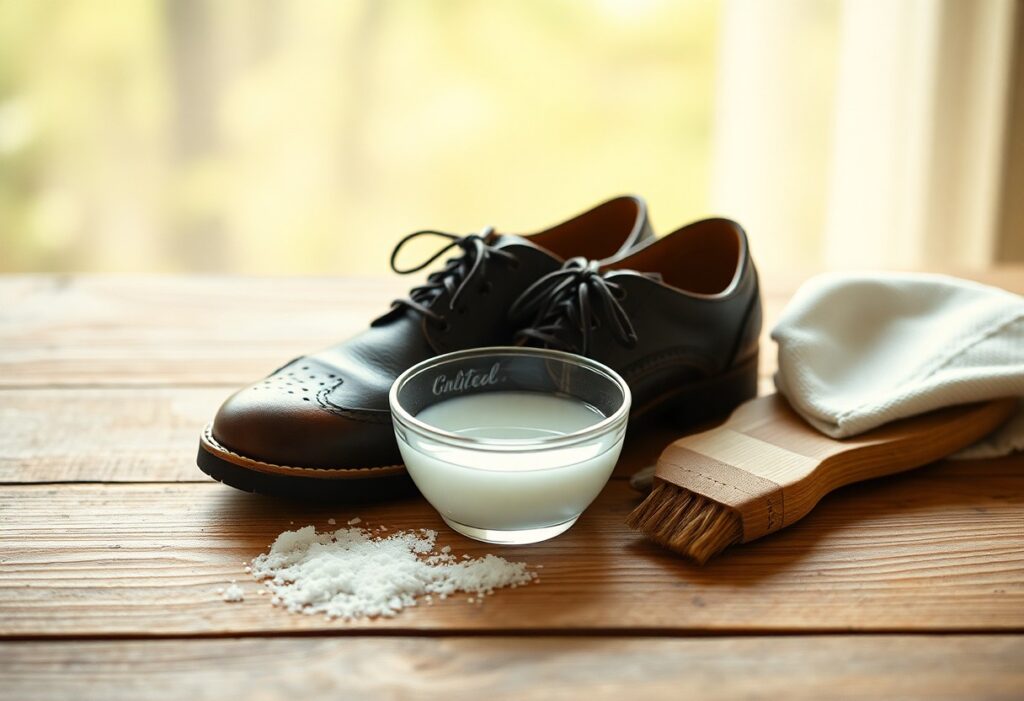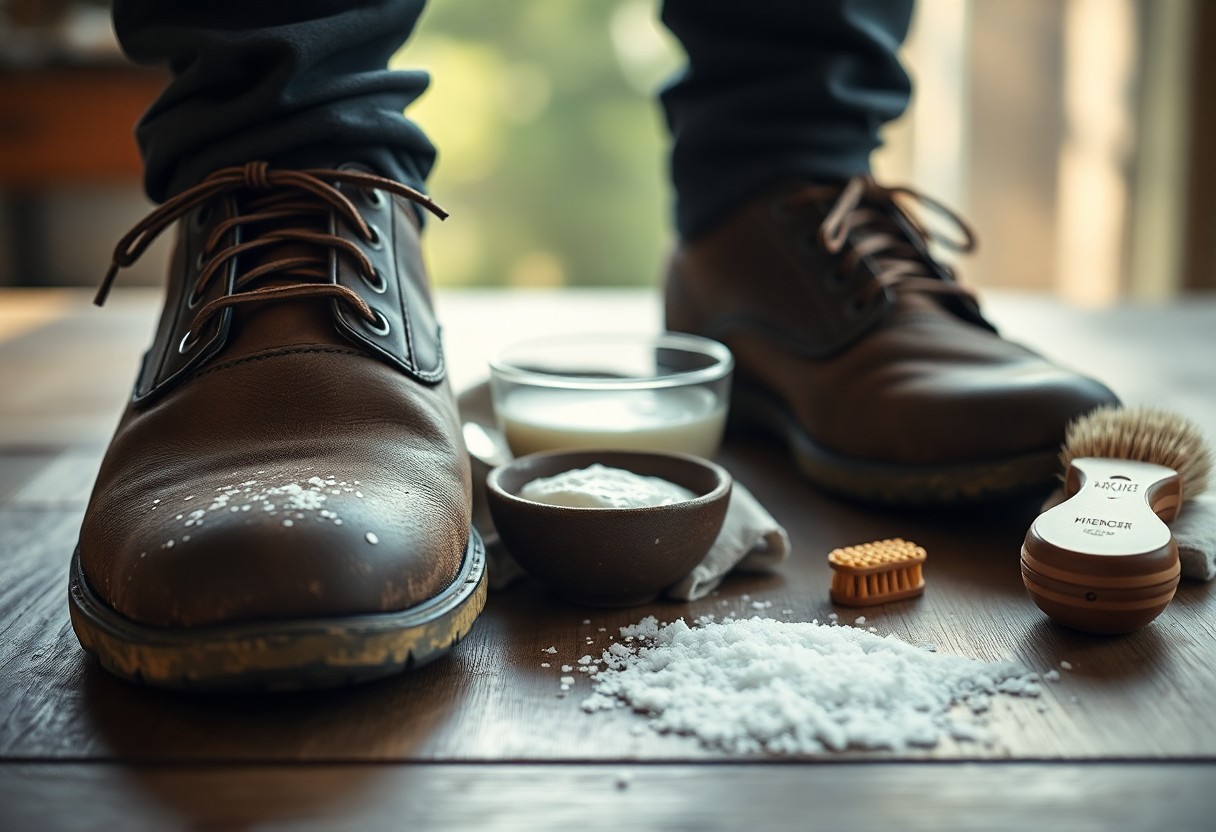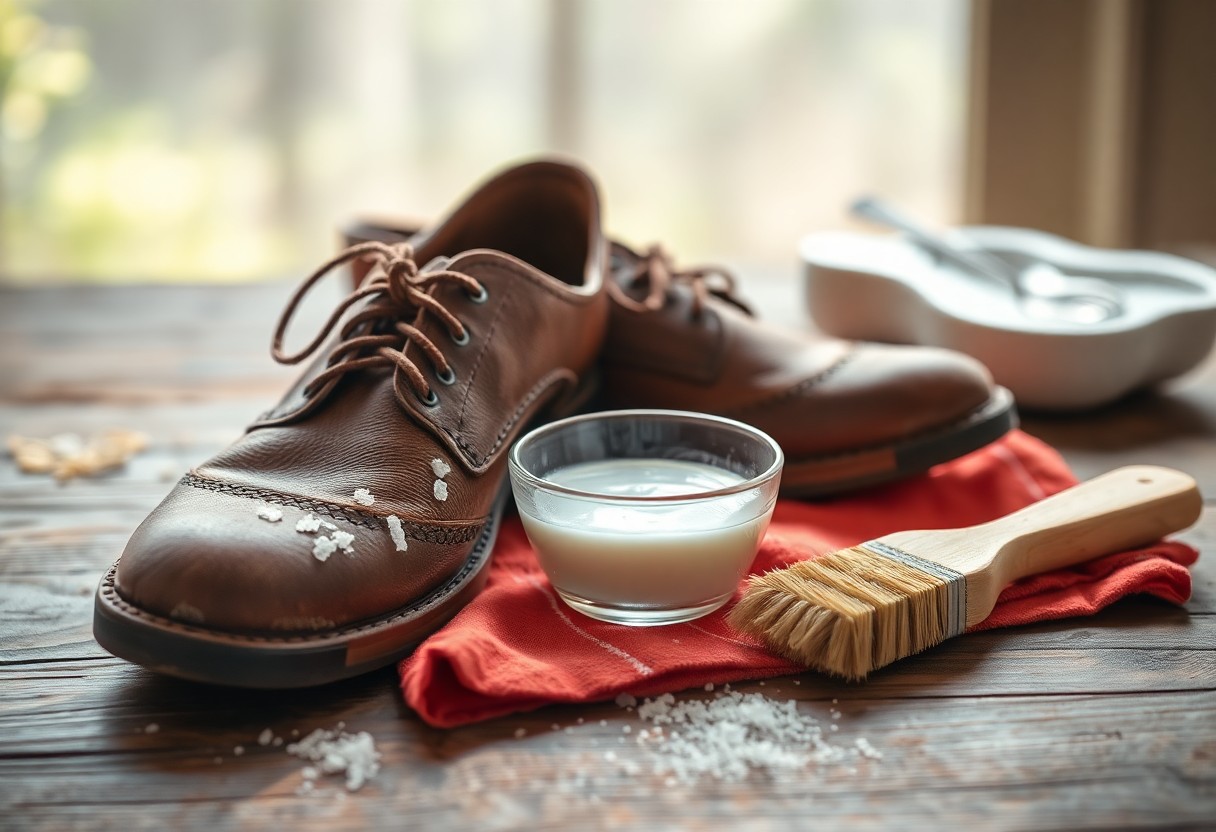
Utilizing effective strategies to safeguard your shoes during the winter months is essential for preventing the harmful effects of road salt. In areas prone to harsh cold, your footwear faces ongoing exposure to corrosive road salt, which can significantly damage leather quality and leave unattractive stains. To maintain the pristine condition of your shoes, proactive measures are paramount, beginning with consistent cleaning and appropriate care techniques. This comprehensive guide will provide you with practical solutions for both preventing and effectively eliminating salt stains, ensuring you extend the lifespan of your shoes while keeping them visually appealing. Discover proven methods for daily upkeep and stain elimination that will protect your footwear throughout the challenging winter season.
Recognizing the Detrimental Effects of Salt Stains on Your Shoes
Grasping the effects of winter conditions combined with road salt is crucial for protecting your footwear. When shoes contact salt-infused snow and slush, they often develop unsightly white residue and permanent stains that can severely compromise both the visual appeal and structural integrity of your shoes. Salt not only diminishes the aesthetic of your footwear but can also cause more severe long-term problems such as cracking and material weakening if left unchecked. Identifying the early signs of salt damage can enable you to take corrective measures before the situation escalates into more severe complications. Timely intervention will not only enhance the appearance of your shoes but also ensure their durability.
Identifying Various Types of Salt Stains Across Different Shoe Materials
- Leather shoes show distinct white rings and patches
- Suede material often develops crusty white deposits
- Canvas shoes may present a powdery white residue
- Synthetic materials could reveal discolored spots
| Material | Characteristics of Salt Stains |
|---|---|
| Leather | Visible white rings and dried patches |
| Suede | Crusty white deposits |
| Canvas | Powdery white residue |
| Synthetic | Discolored spots |
| Nubuck | Rough white patches |
Understanding the Mechanism of Salt Damage on Leather and Other Materials
The primary consequence of salt exposure is the dehydration of leather fibers. Salt acts as a desiccant, pulling essential moisture from your shoes, which can lead to cracking, discoloration, and a general weakening of the material over time. The presence of salt disrupts the natural oils that keep leather supple and resilient, ultimately resulting in a shortened lifespan for your cherished footwear. If neglected, road salt stains can lead to irreversible damage, making it imperative to act swiftly. The corrosive nature of salt deteriorates the natural oils in leather, weakens fiber bonds, and can ultimately result in serious degradation of your shoes. To safeguard your investment, it is critical to address any salt stains within 24 hours to avoid lasting damage that can ruin your footwear.
Proactive Strategies for Preventing Salt Damage to Your Shoes During Winter
To effectively protect your shoes from salt damage, engaging in proactive care strategies is essential. Start by applying a waterproofing treatment to your shoes before the winter season begins, and ensure you regularly apply protective sprays throughout the winter months. These preemptive actions create a protective barrier against salt-infused water, helping to shield your shoes from direct contact with corrosive elements that can harm the leather surface. Furthermore, maintaining a consistent cleaning regimen will bolster your shoes’ resistance to the harsh winter environment.
Applying Pre-treatment Solutions and Protective Measures for Footwear
Enhance your shoes’ defense against salt damage by applying a high-quality leather conditioner followed by a reliable waterproofing spray. It is advisable to reapply these protective layers every 2-3 weeks during the winter months to ensure ongoing protection. For additional durability, consider using a wax-based protector as a supplementary layer of defense against the severe winter conditions that threaten your footwear. Regularly inspecting your shoes for any signs of wear can help you maintain their protective coatings and ensure effectiveness throughout the season.
Best Practices for Winter Shoe Maintenance
Implementing effective winter shoe care techniques is vital for preserving the integrity of your footwear. Focus on daily cleaning and proper storage practices to shield your shoes from salt damage. Consistent cleaning after exposure to salt is critical, as it prevents the accumulation of harmful residues. Additionally, utilizing shoe trees during storage helps maintain shape, while rotating between multiple pairs of shoes minimizes wear and prolongs the life of each pair. Regularly applying protective spray will bolster defenses and ensure your footwear is always prepared to face the elements.
- Clean your shoes immediately after salt exposure
- Utilize shoe trees for shape preservation during storage
- Rotate between multiple pairs of shoes to mitigate wear
- Consistently apply protective spray to maintain defenses
Every winter day poses a risk to your shoes, making vigilance essential. Winter maintenance demands your consistent attention and meticulous care.
- Regularly check weather forecasts for salt warning days
- Keep cleaning supplies accessible at home and work
- Incorporate regular protective treatment days into your routine
- Monitor your shoes’ condition weekly
Remember, prevention is far superior to remedying damage after it occurs. By taking these proactive steps, you can greatly diminish the likelihood of salt stains and maintain your shoes’ appearance throughout the winter.

Comprehensive Step-by-Step Guide for Removing Salt Stains from Your Footwear
Successfully eliminating salt stains from your shoes is achievable by following a systematic approach. This detailed process requires careful attention to detail and the right cleaning supplies to ensure effective stain removal without damaging the leather. The secret to thorough cleaning lies in using gentle techniques that preserve the integrity of the materials.
| Basic Cleaning Items | Advanced Cleaning Items |
| Warm water, Clean cloth, Paper towels | Vinegar, Lemon juice, Leather cleaner |
Initial Cleaning Techniques for Fresh Salt Stains
Salt stains are most effectively treated when addressed immediately. Use a clean, damp cloth to gently wipe your shoes from top to bottom, ensuring that you frequently change the cloth section to avoid spreading the salt further onto the leather. This initial cleaning step is essential as it helps to lift the salt from the surface before it has a chance to seep deeper into the material, causing more harm. After the initial wipe, allow your shoes to air dry naturally to preserve their shape.
Advanced Cleaning Techniques for Stubborn Salt Stains
- Mix equal parts water, vinegar, and lemon juice in a bowl to create a potent cleaning solution.
- Gently apply the solution using a soft cloth, taking care not to saturate the leather.
- Wipe in one direction only to prevent damaging the leather while effectively lifting the stain.
- Be cautious to avoid oversaturating the leather, as this can lead to additional complications.
Successfully tackling stubborn salt stains requires a meticulous approach. Always remember to test cleaning solutions on a small, inconspicuous area first to ensure they won’t harm your shoes. This precaution allows you to proceed with confidence, knowing that your cleaning method will safeguard the quality of your footwear.
| Immediate Care Steps | Long-term Protection Steps |
| Air dry your shoes at room temperature | Apply leather conditioner consistently |
Essential Tools and Recommended Products for Optimal Shoe Care
To effectively address salt stains, it’s important to maintain a well-organized cleaning kit at your disposal. Your basic kit should include clean white cloths, a soft brush, paper towels, and a bowl for mixing cleaning solutions. Always keep a designated cleaning cloth at home and work to enable a swift response to any salt exposure. This preparedness will help you resolve potential issues before they escalate, keeping your shoes in excellent condition.
Top Cleaning Products and Materials for Comprehensive Shoe Care
The most effective cleaning solutions consist of a mixture of equal parts water, vinegar, and lemon juice. Additionally, consider using commercial products like Saphir salt stain remover for enhanced effectiveness. Your cleaning kit should also include leather conditioner, shoe cream, and waterproofing spray for post-cleaning care. Avoid harsh chemicals that could potentially harm your shoes during the cleaning process, as these can lead to further deterioration of the material and negatively affect the overall appearance of your footwear.
Comparing Professional vs. DIY Cleaning Products for Shoe Maintenance
With a variety of both store-bought and homemade solutions available, you have multiple options for your shoe care routine. Professional products often feature specialized formulations designed for efficiency and ease of use, while DIY solutions utilizing household items can be equally effective and more budget-friendly. The choice between these options ultimately depends on the value of your shoes and the frequency with which you need to clean them. Evaluating your needs will aid you in selecting the most suitable approach for maintaining your footwear.
Cleaning products vary greatly in their application methods and effectiveness. Professional cleaners typically provide faster results but come at a higher cost. In contrast, DIY remedies such as the water-vinegar-lemon mixture may require more time and effort but allow you greater control over the ingredients used. The quality and type of your leather shoes should guide your decision on product selection, ensuring you choose the most effective care for your specific footwear.

Key Environmental Factors Affecting Shoe Care During Winter
While there are regional variations, salt exposure and leather damage are influenced by a myriad of environmental factors. The challenges presented to your shoes can differ based on location, climate, and urban infrastructure. Temperature fluctuations, humidity levels, and the type of salt utilized on roads can all significantly impact the severity of staining. Acknowledging these factors empowers you to tailor your protection strategy accordingly. By understanding the conditions your footwear is subjected to, you can make informed decisions regarding their care and maintenance.
The Influence of Weather Conditions on Salt Damage to Footwear
The impact of weather conditions on your shoes’ vulnerability to salt damage can vary significantly. When temperatures hover around freezing, wet conditions increase the risk of salt permeating the leather. You are likely to observe more pronounced staining during freeze-thaw cycles, where temperatures fluctuate drastically between day and night. Your shoes are particularly at risk during early spring when melting snow combines with residual road salt, necessitating extra attention during this transitional period. Being mindful of these patterns will assist you in preparing your footwear for changing conditions.
Optimal Storage and Maintenance Practices for Winter Footwear
During the winter season, proper storage of your shoes is crucial for their protection. It is important to keep your footwear in a dry environment with stable temperatures, away from direct heat sources. Regular cleaning after each use is vital to prevent salt accumulation, while proper ventilation is necessary to avert moisture buildup that could lead to further damage. Consistent attention to detail during winter shoe care is essential. Never store damp shoes in closed spaces, as this can trap moisture and accelerate salt damage. It is advisable to adhere to a regular cleaning schedule and utilize shoe trees to maintain shape and absorb excess moisture. Applying protective treatments before winter begins will create an effective shield against salt exposure.
Comparative Assessment of Available Treatment Methods for Salt Stain Removal
To keep your shoes protected, selecting the right treatment method is vital. Below is a comparison of available options to assist you in making an informed decision:
| Commercial Solutions | Home Remedies |
|---|---|
| Fast-acting formulas | Cost-effective alternatives |
| Specialized protection | Made from natural ingredients |
Weighing the Benefits and Drawbacks of Chemical-based Cleaning Solutions
Utilizing chemical-based solutions offers quick results but requires careful handling and consideration of safety. Here are some factors to consider:
| Pros | Cons |
|---|---|
| Rapid effectiveness | Higher overall cost |
| Long-lasting protective benefits | Potential use of harsh chemicals |
| Professional-grade results | Possible environmental impact |
| Consistent performance | Specific storage requirements |
Examining Natural Remedies: Advantages and Disadvantages for Shoe Maintenance
While natural remedies may require more time to produce results, they provide safer alternatives for both your shoes and the environment. Natural solutions, such as vinegar and lemon juice mixtures, offer gentle cleaning action without the risk of harsh chemicals. Although these methods may necessitate more frequent application, they are budget-friendly and readily available in most households, making them a practical choice for many shoe owners. Opting for natural options enables you to care for your footwear without introducing potentially harmful substances into your cleaning routine.

Establishing a Long-term Care Routine for Your Footwear
To ensure your shoes remain shielded against salt damage throughout the year, it is vital to adopt a comprehensive care routine. This routine should encompass regular waterproofing treatments, deep cleaning at the change of seasons, and appropriate storage during off-seasons. After winter, performing a thorough inspection and restoration of your footwear is essential for maintaining both durability and appearance. Establishing a consistent care routine will significantly enhance the longevity and performance of your shoes, ensuring they endure the test of time.
Post-treatment Maintenance Strategies for Long-lasting Shoe Protection
Even after successfully removing salt stains, your shoes require ongoing care to prevent future damage. Key maintenance steps include:
- Weekly conditioning of leather surfaces to maintain suppleness
- Application of protective sprays every month to ensure a barrier
- Storage of shoes with cedar shoe trees to preserve shape and absorb moisture
- Use of protective covers during wet conditions to shield against exposure
After treating salt stains, always allow your shoes to air dry naturally for at least 24 hours to ensure they retain their shape and integrity. This crucial step is essential for maintaining the overall quality and appearance of your footwear.
Creating a Consistent Care Schedule for Optimal Footwear Maintenance
Maintaining your shoes should follow a structured schedule for optimal care. Clean your shoes after each wear during the winter months, apply protective spray every 4-6 weeks, and perform deep conditioning treatments monthly to keep them in excellent condition. It is essential to recognize that prevention is better than cure regarding salt damage. Your regular care routine should include daily wiping, weekly cleaning, and monthly protection treatments. This systematic approach not only extends the lifespan of your footwear but also ensures they maintain their appearance through the challenges posed by winter conditions.
Key Insights for Protecting and Caring for Your Shoes
Equipped with these insights, your most effective strategy against salt damage combines proactive prevention with timely action. To safeguard your shoes, make it a habit to wipe them down right after exposure to salt, employing proper techniques and suitable cleaning solutions. If you discover salt stains, respond quickly with a vinegar-water-lemon solution or specialized cleaners. Always follow up by conditioning your leather to restore lost moisture. By implementing these straightforward measures, you’ll be able to keep your shoes looking impeccable and extend their lifespan throughout the winter months.
Your Questions Answered: FAQs About Shoe Care
Q: What measures can I take to prevent salt stains on my leather shoes during winter?
A: To avert salt stains, promptly clean your shoes after contact with salt using a damp cloth with warm water. Wipe from top to bottom in a single direction, changing the cloth section frequently. Additionally, applying a leather protector before the winter season begins can create an effective barrier against salt damage. This proactive approach is vital for maintaining the quality of your footwear.
Q: What is the most effective homemade solution for eliminating existing salt stains from leather shoes?
A: Create a mixture using equal parts water, vinegar, and lemon juice for an effective salt-dissolving solution. Use this mixture with a clean cloth, wiping from top to bottom, and clean the cloth often during the process. After removing the salt, wipe the shoes with plain water using a fresh cloth, then allow them to dry completely before applying leather conditioner. This method ensures thorough cleaning while preserving the integrity of the leather.
Q: How can I tell if I have successfully removed all salt from my shoes?
A: Inspect for any remaining white residue on the leather surface; if none is visible, you have likely removed all the salt. Be aware that dark stains may persist even after salt removal. These marks indicate areas where the salt has compromised the leather, but they do not signify active salt presence. Always condition the leather after cleaning to replenish moisture and enhance durability.
The Article Guide to preventing and removing salt stains from shoes effective tips and techniques appeared first on My Shoes Finder
The Article Preventing and Removing Salt Stains from Shoes: Effective Tips Was Found On https://limitsofstrategy.com
The Article Effective Tips for Preventing Salt Stains on Shoes First Appeared ON
: https://ad4sc.com
Comments are closed